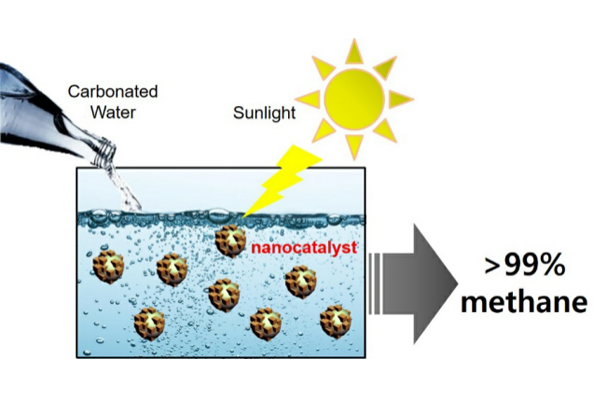As a flagship research project of Saudi Aramco-KAIST CO2 management center, Prof. Hyunjoon Song and his research team were focusing on well-defined nanostructured catalytic systems to promote the direct conversion of carbon dioxide into value-added compounds. There has been intensive research on these reactions via various routes such as photochemical, electrochemical, and biological approaches. Among them, a photochemical method with sunlight in aqueous solutions is regarded as an ultimate approach due to the prospect of using free and plentiful solar energy and water without damaging the environment. However, the catalysts developed thus far exhibited almost negligible activities, because the photocatalytic pathways of carbon dioxide conversion are sophisticated, with multistep coupling of photophysical excitation, electron transfer, and surface reaction processes.
Prof. Song and his research team selected Zn(II) oxide and Cu(I) oxide as representative semiconductor metal oxides, where Zn-Cu mixed oxides were known as photocatalysts for dye degradation. Their main strategy was the design of nanostructured catalysts in a colloidal form with well-defined domains and junctions, which could make the reaction pathway simple and effective. As a result, they successfully grew single-crystalline Cu(I) oxide nanocubes on ZnO nanospheres, generating uniform ZnO-Cu2O hybrid nanoparticles with well-defined surface structures. In the absence of any additional sacrificial reagents, direct carbon dioxide reduction occurred by the colloidal ZnO-Cu2O catalysts in neutral carbonated water under ambient pressure at room temperature. The conversion rate was measured to be 1080 mmolgcat-1h-1 with a quantum yield of 1.5%, which were the highest activities ever reported in aqueous media. Surprisingly, even with the use of water as a solvent, the selectivity of methane production exceeded 99%, whereas the other catalysts such as titania mainly generated hydrogen gas through water reduction. This high performance was attributed to the energetic match between the two distinct components, as well as their defect-less surface and uniform junctions, which suppressed charge recombination and enhanced effective charge transfer. This strategy to design well-defined nanostructures in colloidal forms can be expandable to various materials for photochemical reactions. It might also have a significant impact on the understanding of the photochemical mechanism needed to achieve maximum catalytic performance.
This result was highlighted in domestic and international scientific magazines. One interesting news article in El Confidencial was entitled “Closer to the Elon Musk Martian engine: they manage to create methane with CO2 and solar energy”. They reported that Prof. Song’s team presented an analogous formula that the founder of SpaceX longed to achieve to travel back and forth to Mars. To survive in Mars, CO2 generated inside the closed system must be removed, but the research team showed a pathway using sunlight directly converting CO2 to methane, which would be reused as an energy source to operate the system in Mars.


Prof. Hyunjoon Song (Department of Chemistry)
Homepage: http://small.kaist.ac.kr
E-mail: hsong@kaist.ac.kr






